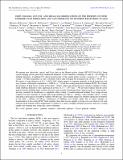DEEP CHANDRA , HST-COS, AND MEGACAM OBSERVATIONS OF THE PHOENIX CLUSTER: EXTREME STAR FORMATION AND AGN FEEDBACK ON HUNDRED KILOPARSEC SCALES
Author(s)
McNamara, Brian R.; Weeren, Reinout J. van; Applegate, Douglas E.; Bayliss, Matthew; Bautz, Marshall W.; Benson, Bradford A.; Carlstrom, John E.; Bleem, Lindsey E.; Chatzikos, Marios; Edge, Alastair C.; Fabian, Andrew C.; Garmire, Gordon P.; Hlavacek-Larrondo, Julie; Jones-Forman, Christine; Mantz, Adam B.; Stalder, Brian; Veilleux, Sylvain; ZuHone, John A.; McDonald, Michael A.; Miller, Eric D; ... Show more Show less
DownloadMcDonald-2015-Deep Chandra, HST-CO.pdf (2.880Mb)
PUBLISHER_POLICY
Publisher Policy
Article is made available in accordance with the publisher's policy and may be subject to US copyright law. Please refer to the publisher's site for terms of use.
Terms of use
Metadata
Show full item recordAbstract
We present new ultraviolet, optical, and X-ray data on the Phoenix galaxy cluster (SPT-CLJ2344-4243). Deep optical imaging reveals previously undetected filaments of star formation, extending to radii of ~50–100 kpc in multiple directions. Combined UV-optical spectroscopy of the central galaxy reveals a massive (2 × 10[superscript 9] M[subscript ⊙]), young (~4.5 Myr) population of stars, consistent with a time-averaged star formation rate of 610 ± 50 M[subscript ⊙] yr[superscript −1]. We report a strong detection of O vi λλ1032,1038, which appears to originate primarily in shock-heated gas, but may contain a substantial contribution (>1000 M[subscript ⊙] yr[superscript −1]) from the cooling intracluster medium (ICM). We confirm the presence of deep X-ray cavities in the inner ~10 kpc, which are among the most extreme examples of radio-mode feedback detected to date, implying jet powers of 2–7 × 10[superscript 45] erg s[superscript −1]. We provide evidence that the active galactic nucleus inflating these cavities may have only recently transitioned from "quasar-mode" to "radio-mode," and may currently be insufficient to completely offset cooling. A model-subtracted residual X-ray image reveals evidence for prior episodes of strong radio-mode feedback at radii of ~100 kpc, with extended "ghost" cavities indicating a prior epoch of feedback roughly 100 Myr ago. This residual image also exhibits significant asymmetry in the inner ~200 kpc (0.15R[subscript 500]), reminiscent of infalling cool clouds, either due to minor mergers or fragmentation of the cooling ICM. Taken together, these data reveal a rapidly evolving cool core which is rich with structure (both spatially and in temperature), is subject to a variety of highly energetic processes, and yet is cooling rapidly and forming stars along thin, narrow filaments.
Date issued
2015-09Department
Massachusetts Institute of Technology. Department of Physics; MIT Kavli Institute for Astrophysics and Space ResearchJournal
The Astrophysical Journal
Publisher
IOP Publishing
Citation
McDonald, Michael, Brian R. McNamara, Reinout J. van Weeren, Douglas E. Applegate, Matthew Bayliss, Marshall W. Bautz, Bradford A. Benson, et al. “DEEP CHANDRA , HST-COS, AND MEGACAM OBSERVATIONS OF THE PHOENIX CLUSTER: EXTREME STAR FORMATION AND AGN FEEDBACK ON HUNDRED KILOPARSEC SCALES.” The Astrophysical Journal 811, no. 2 (September 28, 2015): 111. © 2015 The American Astronomical Society
Version: Final published version
ISSN
1538-4357
0004-637X